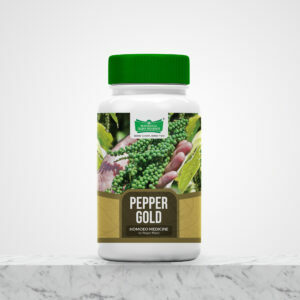Pepper Gold is a special homeopathic treatment designed to enhance the quality and health of crops which is obtained from the vines like Pepper and Betel. This innovative preparation aims to improve not only the vitality of plants, but also the overall ecosystem that thrives. Using homeopathic principles, Pepper Gold strives to create a balanced environment for these crops, thereby promoting their growth and productivity.
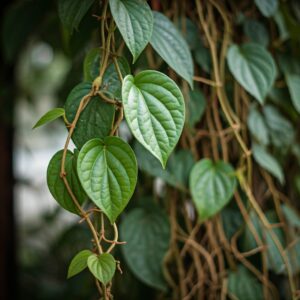
Using Pepper Gold promotes healthier plant growth, enriches the soil, and promotes a sustainable approach to agriculture. The solution meets the growing demand for environmentally friendly farming methods and helps reduce reliance on synthetic chemicals while supporting the natural biodiversity of agricultural ecosystems. With a focus on improving crop quality and ecosystem health, Pepper Gold represents a forward-thinking approach to modern agriculture that benefits for farmers. Main objective of the development of this medicine is to help farmers to improve their yield and immunity of their plants. Since demand for pepper is high worldwide, it is also termed as “Black Gold”. Betel leaves are also a great income of farmers in Kerala. Therefore a need for designing a medicine to improve the the health and yield of Pepper as well as betel became a necessary.
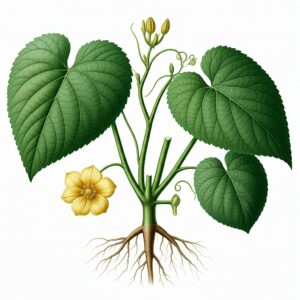 Vines are characterized by a climbing or creeping habit and often have specialized structures that enable them to attach to surfaces or other plants. Here are some morphological characteristics commonly found in vines.
Vines are characterized by a climbing or creeping habit and often have specialized structures that enable them to attach to surfaces or other plants. Here are some morphological characteristics commonly found in vines.
Tendril: A thin, flexible structure that wraps around an object to provide support. These may be modified leaves, stems, or roots.
Aerial roots: Some vines develop adventitious roots that grow from the stem and attach to surfaces.
Climbing stems: The stems of some vines can wrap around objects and climb.
Flower Structure: Vine flowers vary greatly in size, shape, and color. They may be single or in clusters.
Tap roots or fibrous roots: Vines have tap roots (the main root) or fibrous roots (a network of small roots).
Adventitious roots: As mentioned above, some vines develop aerial roots.
Climbing Mechanisms: Some vines have specialized climbing mechanisms, such as thorns, prickles, or hooks.
Succulent : Some vines have succulent stems or leaves, allowing them to retain water in dry conditions. Leaf changes: Depending on the type of grape, the leaves may change into vines or thorns.
Betel and Pepper like plants need a balanced supply of nutrients to stay healthy. It can be categorized into Macronutrients and Micro nutrients. Macro nutrients are the nutrients they need in a large quantity. And the micronutrients are the one they require in smaller quantity

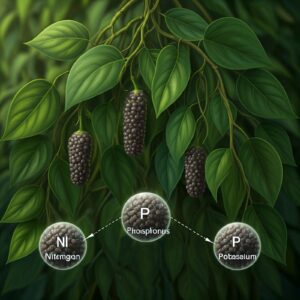 Macronutrients needed for vines
Macronutrients needed for vines
Nitrogen (N) is essential for protein synthesis, chlorophyll production, and overall plant growth.
Phosphorus (P) plays a critical role in root growth, energy transfer, and the ripening of flowers and fruits.
Potassium (K) is essential for plant photosynthesis, enzyme activity, and water balance.
Calcium (Ca): Essential for cell wall structure, nutrient absorption, and disease resistance.
Magnesium (Mg) is necessary to create chlorophyll and a photosynthesis process.
Sulfur(s): plays a role in the creation of proteins and the work of enzymes.
Micronutrients
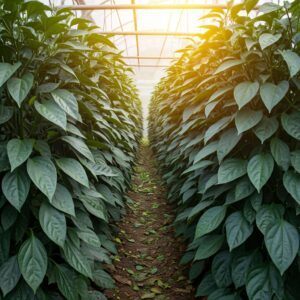 These are nutrients that plants need in smaller amounts, but they are just as important as the macronutrients. They’re like the vitamins and minerals in our diets, essential for various functions and overall health.
These are nutrients that plants need in smaller amounts, but they are just as important as the macronutrients. They’re like the vitamins and minerals in our diets, essential for various functions and overall health.
Iron (Fe): Think of iron as the plant’s red blood cells. It helps plants produce chlorophyll, the green pigment that helps them capture sunlight for energy. Without iron, plants would be pale and weak, like a person with anemia.
Manganese (Mn): Manganese is involved in many plant processes, including photosynthesis and water balance. It’s like the plant’s energy regulator, helping to keep things running smoothly.
Zinc (Zn): Zinc is a versatile nutrient that plays a role in enzyme activity, protein synthesis, and plant growth. It’s like the plant’s jack-of-all-trades, helping out with a variety of tasks.
Copper (Cu): Copper is another essential nutrient for photosynthesis, enzyme activity, and nutrient uptake. It’s like the plant’s conductor, helping to coordinate various processes and keep everything in harmony.
Boron (B): Boron is involved in cell wall structure, pollen development, and fruit set. It’s like the plant’s builder, helping to strengthen its structure and reproductive parts. Without boron, plants might have weak stems and struggle to produce flowers and fruit.
Molybdenum (Mo): Molybdenum is a key player in nitrogen fixation, a process that helps plants convert atmospheric nitrogen into a usable form. It’s like the plant’s nitrogen fixer, helping to ensure it has enough of this essential nutrient.
Chlorine (Cl): Chlorine is involved in photosynthesis and water balance. It’s like the plant’s water manager, helping to regulate its hydration levels. Without chlorine, plants might become dehydrated or waterlogged.
How Pepper Gold benefits plants like Pepper and Betel?
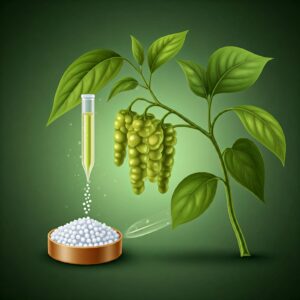 Pepper Gold is a carefully selected remedy in Agro- Homepathy to Benefit especially Pepper as the name suggests. Researchers in Manakkal Pharma has learned the symptoms which occur in the Pepper plant after the contraction of pathogen and formulated the medicine to treat the symptoms. A formulae has created to bring the physiological changes which increases the chlorophyll content. Medicine is proven to target the receptors which stimulate the growth hormone, enzymes for immunity, overall nutrient flow. Pepper is a very delicate and sensitive plant. It can easily contract disease and die. Defense mechanism in pepper is activated when the medicine is applied. Some of the Enzymes related to Pepper are
Pepper Gold is a carefully selected remedy in Agro- Homepathy to Benefit especially Pepper as the name suggests. Researchers in Manakkal Pharma has learned the symptoms which occur in the Pepper plant after the contraction of pathogen and formulated the medicine to treat the symptoms. A formulae has created to bring the physiological changes which increases the chlorophyll content. Medicine is proven to target the receptors which stimulate the growth hormone, enzymes for immunity, overall nutrient flow. Pepper is a very delicate and sensitive plant. It can easily contract disease and die. Defense mechanism in pepper is activated when the medicine is applied. Some of the Enzymes related to Pepper are
Chitinases and β-1,3-glucanases: Consider the enzymes chitinase and β-1,3-glucanase as miniature troops equipped with certain tools. They go after the tough materials found in fungal infections’ cell walls, such as chitin and β-1,3-glucan. These compounds are broken down by these enzymes, which weakens pathogen defenses and facilitates plant defensive mechanisms.
Peroxidases: Consider peroxidase to be the plant’s repair crew. These fortify the plant’s own cell walls, increasing their defense against harm. They accomplish this by joining the various parts of the cell wall to form a more robust wall.
Polyphenoloxidases: These enzymes function similarly to a plant’s poison factory. They create poisonous substances that are harmful to microorganisms. This makes the environment hostile to the invaders and makes it harder for them to live.
Defensins: They are small but powerful peptides which have the capability to drive out their growth. It provides toughest defense to all kind of pathogens entering into the system of Pepper plant.

The medicine contained Nano particles resulting from the Dilutions and intense oscillating of the drug which will create a more potent tiny nano materials with the solvent, It can readily enter into the system and helps resolve all of the plant’s issues from stage 1 of the growth to the crop yielding.
Benefits of Pepper Gold
Growing pepper plants with Pepper Gold can significantly improve their health, output, and growth. This Remedy is meant to fortify the plants’ general vitality, guaranteeing that they flourish during their entire growth cycle.
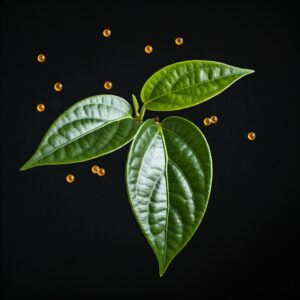 The capacity of the Pepper gold to decompose microbes in the soil is one of their main benefits. The treatments aid in establishing a more wholesome soil environment by focusing on and eliminating certain pathogens. The medicine is equipped to breakdown chemicals formed by the long term addition of chemical fertilizer. It will increases soil fertility while also shielding the plants from disease. As the soil gets richer, it supplies vital minerals that encourage healthy plant growth.
The capacity of the Pepper gold to decompose microbes in the soil is one of their main benefits. The treatments aid in establishing a more wholesome soil environment by focusing on and eliminating certain pathogens. The medicine is equipped to breakdown chemicals formed by the long term addition of chemical fertilizer. It will increases soil fertility while also shielding the plants from disease. As the soil gets richer, it supplies vital minerals that encourage healthy plant growth.
Pepper Gold also encourage profuse flowering and fruiting, which increases the likelihood of a plentiful harvest and delivers better yields. The treatment improves the quality of the fruits that are produced and are essential for the recovery of stunted plants. They are able to overcome obstacles to their progress and realize their full potential as a result.
Growers should anticipate a more robust harvest, higher output, and better soil health as a result, which should boost their level of pleasure and financial success in their pepper farming ventures. This all-encompassing strategy not only promotes environmentally friendly agricultural methods but also increases pepper’s resistance.
Usage
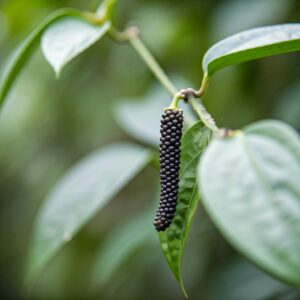 Preparing the solvent: Gather everything you need: 50 tablets and 3 liters of water. Use a bucket or large mixing container.
Preparing the solvent: Gather everything you need: 50 tablets and 3 liters of water. Use a bucket or large mixing container.
Dissolving the tablets: Start by placing the tablets in the water. Stir the mixture well with a long spoon or stick until all the tablets are completely dissolved. This process is very important as it ensures that the nutrients are evenly distributed throughout the solution.
- HOW TO APPLY Aim for the roots: When you’re ready to apply. Carefully pour the nutritional solution to the base of the plant aimed at moistening the roots. It is essential to distribute the solution evenly because the nutrient is optimal absorption. Avoid overwatering: While it’s important to keep the soil moist, be careful not to over-saturate it.
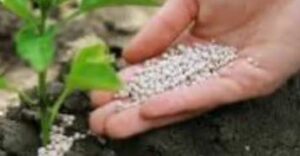 Frequency of Application
Frequency of Application
Every 3 months: To maintain good health, repeat this routine of medication every 3 months. Mark your calendar or set a reminder so you don’t forget. Consistent fertilization is essential to maintaining soil nutrient levels and ensuring sustainable growth.
- Pest Management
Using the spray solution: If you notice pests or wilting, use the medicine solution to spray the leaves. Fill the sprayer with a solution and apply plenty to the top and bottom of the leaves. This method helps to eliminate pests while providing nutrients to plants.
